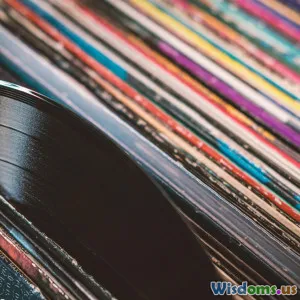
Is Vinyl Making a Comeback or Just Nostalgia
8 min read Explore vinyl's resurgence beyond nostalgia, examining its cultural, economic, and technological impact in today's music landscape. (0 Reviews)
Is Vinyl Making a Comeback or Just Nostalgia?
Vinyl records, once considered obsolete by many in the digital era, have made an unexpected and compelling resurgence in recent years. Walk into any record store today, and you'll witness shelves stocked with new releases pressed on vinyl. Collectors and casual listeners alike are spinning records with enthusiasm reminiscent of decades past. But is this wave of vinyl enthusiasm simply nostalgic longing for a bygone era, or does it signify a genuine and sustainable comeback?
An Unexpected Revival: Vinyl’s Journey From Obsolescence to Popularity
Vinyl’s decline started earnestly in the late 1980s with the introduction of CDs offering a more portable and durable format. The convenience of digital files and streaming seemed to mark the end of analog music mediums. However, the late 2000s brought a surprising reversal. According to the Recording Industry Association of America (RIAA), vinyl sales in the United States have steadily increased every year since 2007, surpassing 41 million units sold in 2022, a peak not seen since the 1980s.
What's Behind the Resurgence?
1. A Tangible Music Experience in a Digital Age
Vinyl offers a physical connection to music that digital streaming cannot replicate. The act of placing a record on a turntable, seeing the album art, and hearing the warm, rich analog sound forms an immersive experience. Audiophile communities often highlight that vinyl can provide a dynamic range and sonic warmth often compressed in digital formats.
2. Cultural Statements and Identity
Much of vinyl’s popularity is tied to cultural identity and lifestyle. Owning vinyl records can serve as a statement of authenticity, connoisseurship, and appreciation for music history. For younger generations, particularly Millennials and Gen Z, vinyl offers a way to engage with music tangibly, circumventing the ephemeral nature of playlists and streaming.
3. Collectibility and Artistic Value
Vinyl records are valued collectible items, frequently released with limited-edition artwork, colored discs, and liner notes. This artistic and collectible appeal transcends pure auditory pleasure and feeds into communities dedicated to collecting.
4. Support From the Music Industry and Artists
Major and independent record labels alike have embraced vinyl. Artists from various genres now consider vinyl releases integral to their promotional strategies. Notably, classic artists have reissued albums on vinyl, often remastered to appeal both to purists and newer fans.
Data That Tells the Story
- Global Sales Trends: The International Federation of the Phonographic Industry (IFPI) reported global vinyl revenues reached over $1 billion in 2022, fueling a 20-year growth trend.
- Vinyl vs. Streaming: While streaming dominates overall consumption, vinyl has become the only physical format consistently showing double-digit growth.
Is Vinyl Just Nostalgia?
The Nostalgia Factor
Certainly, many adopters of vinyl are motivated by nostalgia—a yearning for an era before the dominance of digital music. Older generations reminisce about records as ritualistic experiences, bonding opportunities, and treasured memories.
However, this explanation alone is insufficient. The engagement of younger listeners with no direct vinyl-era experience suggests something more nuanced is at play.
Beyond Nostalgia: Millennials and Gen Z
Research by Nielsen Music and MRC Data shows that approximately 65% of vinyl buyers in recent years are under 35. This demographic is technologically savvy, yet actively seeks the sensory and tactile experiences vinyl uniquely provides.
The “Experience Economy” and Music Consumption
The vinyl resurgence coincides with broader trends in consumer behavior emphasizing experience over mere ownership. Vinyl embodies this ethos, offering an active listening process contrasting with the passive consumption model of streaming.
The deliberate selection, playing, and appreciation of vinyl aligns with contemporary consumer desires for mindfulness and authenticity.
Industry Adaptations and Innovations
New Turntables and Accessories
The market has responded with affordable, stylish turntables from brands like Audio-Technica, Pro-Ject, and Fluance, designed to appeal to entry-level and advanced users.
Incorporation of Technology
Innovations include USB turntables capable of digitizing analog collections and Bluetooth-enabled devices bridging old and new worlds.
Limited Edition and Custom Pressings
Special releases cater to collectors, increasing vinyl’s cachet and market value. Examples include Record Store Day exclusives and anniversary editions, driving demand and fostering community events.
Challenges to Vinyl's Longevity
Despite the exciting growth, vinyl faces challenges:
- Environmental Impact: Production uses plastics and chemicals, raising sustainability concerns.
- Accessibility and Cost: Vinyl is relatively expensive, limiting mass-market adoption.
- Physical Fragility: Records and equipment require care and infrastructure.
However, industry innovations in sustainable materials and pressing processes are beginning to address some of these concerns.
Voices From the Industry
Quote from Vinnie Calabro, Owner of Third Man Records:
"Vinyl isn’t just nostalgia; it’s about a real, tangible connection to music — something you can hold and hear in a way that streaming just can’t replicate."
Artist Insight from Jack White:
"I see vinyl as a form of art and expression. It’s a statement about how seriously you care about the music you create and consume."
Conclusion: A Vinyl Renaissance Driven by More Than Memory
Vinyl’s comeback is a complex phenomenon driven by more than mere nostalgia. It reflects a convergence of consumer desires for tactile, authentic experiences, artistic appreciation, and cultural identity expressions. While the digital revolution transformed music accessibility, vinyl offers a meaningful counterpoint––a revival embracing history while innovating for the present.
For music lovers and industry players, vinyl’s persistent renaissance underscores how cultural artifacts can evolve, offering renewed relevance in unexpected ways. Thus, whether a seasoned collector or curious newcomer, spinning vinyl invites participation not only in music but in a broader experience rooted in sound, story, and community.
References
- RIAA, "Year-end Music Industry Revenue Reports"
- IFPI Global Music Report 2023
- Nielsen Music/MRC Data "Vinyl Buyer Demographics"
- Interview with Vinnie Calabro, Third Man Records
- Jack White Interviews, Rolling Stone
Rate the Post
User Reviews
Popular Posts


















